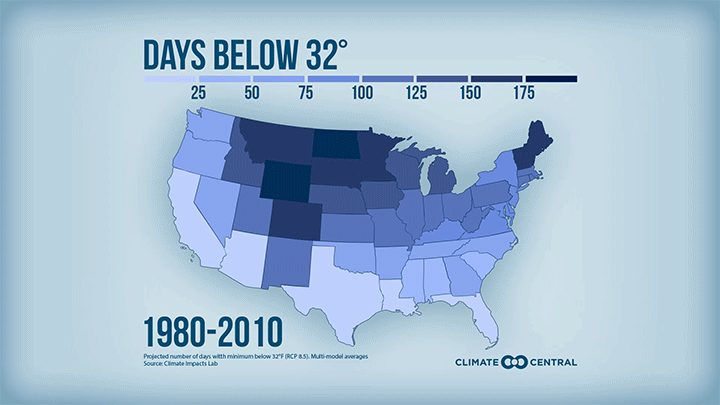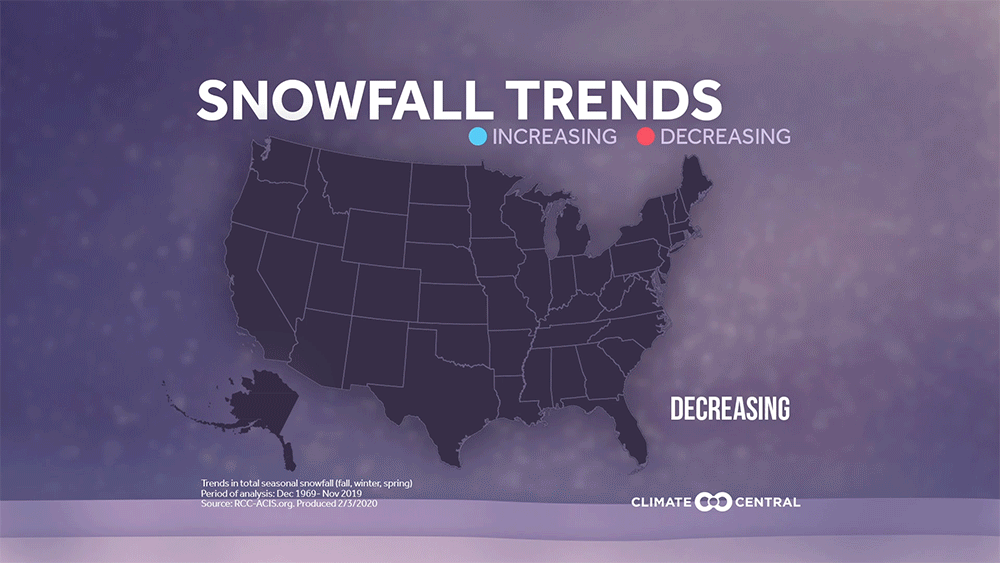WHAT YOU NEED TO KNOW
A warmer climate affects snowfall, melting snow into rain as it falls and when it’s on the ground. In the United States, winters are the fastest warming season for much of the country, the longest cold snaps are becoming shorter, and the number of days with temperatures below 32°F is expected to continue to decline across the country.
Counterintuitively, climate change is causing increased snowfall in some colder climates. Warmer temperatures cause more evaporation. Because warmer air “holds” more moisture—about an additional four percent of water evaporates per degree (F)—that additional moisture can fall as snow when temperatures are below freezing.
Snow keeps our planet cooler, significantly affects water resources, and is a revealing indicator of climate change.
Snow (or the lack of it) has direct impacts on the economy, with consumer spending by snowboarders, skiers and snowmobilers adding an estimated $20.3 billion to the U.S. economy in the 2015-16 winter season.

HOW WE GOT THE DATA
Total annual and seasonal (fall, winter, and spring) snowfall data from 1970-2019 were obtained from the Applied Climate Information System. Average annual snowfall in the first (1970-1979) and last (2010-2019) decade of the study period was compared at each location that receives an average annual snowfall of at least five inches. Stations with more than 20% missing daily data (2 years) in either the first or last decade were excluded from the analysis. For the seasonal analysis that spanned the full fifty-year period, stations missing more than 20% of daily data (10 years) for any season over the study period were excluded. Seasonal snowfall trends were analyzed using linear regression analysis.
POTENTIAL LOCAL STORY ANGLES
What’s the snow forecast for where you live?
The National Weather Service’s Winter Page provides maps and forecasts for snow and ice in your area. Their Winter Weather Desk provides twice-daily updated forecasts for snow, freezing rain, and other wintry conditions around the country.
How is climate change impacting winter activities and tourism near you?
Last year, Climate Central issued the report On Thin Ice, about winters heating up with serious consequences for America’s cold-weather sports economy. Protect Our Winters, a non-profit advocacy group concerned with climate change’s effect on winter sports and recreation, published a 2018 economic analysis that contains state-level data. And here are links to national winter sports organizations that have searchable databases to find sources or activities near you:
And if you have a professional hockey team near you, check for local initiatives at NHL Green, the National Hockey League’s sustainability program that aims to lower emissions, conserve water and reduce waste so future generations can continue the tradition of playing hockey outdoors.
Tools for reporting on winter weather events near you:
Warmer temperatures can make winter storms more complicated, with sleet and freezing rain. Criteria for winter storm watches, advisories, and warnings can vary by region so check out your local National Weather Service office. The NWS also provides helpful information on how to stay safe in winter conditions, wind chill charts, and an explanation of the polar vortex. And the National Snow and Ice Data Center (NSIDC) has just about everything you need to know about snow.
LOCAL INTERVIEW IDEAS
The SciLine service,500 Women Scientists or the press offices of local universities may be able to connect you with local scientists or climatologists who have expertise on the impacts of climate change on weather trends in your area.
The American Association of State Climatologists is a professional scientific organization composed of all 50 state climatologists. Or check in with your local National Weather Service office.
NATIONAL INTERVIEW SUGGESTIONS
David Robinson
Distinguished Professor
NJ State Climatologist
Department of Geography & NJ Agricultural Experiment Station, Rutgers University
Phone: (848) 445-4741
Email: david.robinson@rutgers.edu
Mario Molina
Executive Director, Protect our Winters
Media contact: Sam Kilgore, sam@protectourwinters.org, 206-310-5393
*Available for interviews in Spanish and English
Jennifer Brady
Manager, Analysis and Production, Climate Central, Email: jbrady@climatecentral.org

